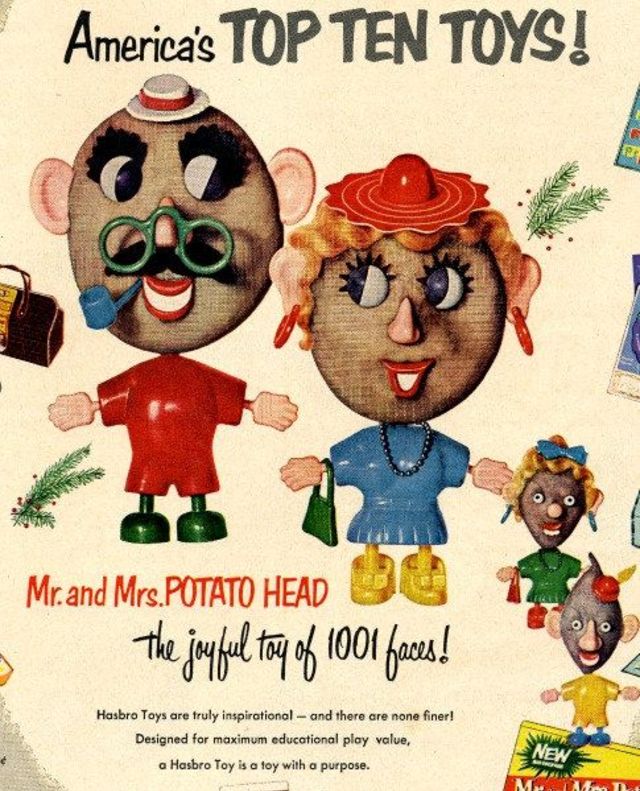Mr. Potato Head is an American toy consisting of a plastic model of a potato which can be decorated with a variety of plastic parts that can attach to the main body. These parts usually include ears, eyes, shoes, a hat, a nose, and a mouth. The toy was invented and developed by George Lerner in 1949 and first manufactured and distributed by Hasbro in 1952.

In the early 1940s, Brooklyn-born toy inventor George Lerner came up with the idea of inserting small, pronged body and face parts into fruits and vegetables to create a “funny face man.” Some speculate he got the idea from his wife’s nephew Aaron Bradley, who was seen placing sticks inside of potatoes in the family garden. Lerner would often take potatoes from his mother’s garden and, using various other fruits and vegetables as facial features, he would make dolls with which his younger sisters could play. The grape-eyed, carrot-nosed, potato-headed dolls became the principal idea behind the plastic toy which would later be manufactured.
In the beginning, Lerner’s toy proved controversial. With World War II and food rationing a recent memory for most Americans, the use of fruits and vegetables to make toys was considered irresponsible and wasteful. Toy companies rejected Lerner's creation. After several years of trying to sell the toy, Lerner finally convinced a food company to distribute the plastic parts as premiums in breakfast cereal boxes. He sold the idea for $5,000. But in 1951, Lerner showed the idea to Henry and Merrill Hassenfeld, who conducted a small school supply and toy business called Hassenfeld Brothers (later changed to Hasbro). Realizing the toy was quite unlike anything in their line, they paid the cereal company $2,000 to stop production and bought the rights for $5,000. Lerner was offered an advance of $500 and a 5% royalty on every kit sold. The toy was dubbed Mr. Potato Head and went into production.




Mr. Potato Head was “born” on May 1, 1952. The original toy cost $0.98, and contained hands, feet, ears, two mouths, two pairs of eyes, four noses, three hats, eyeglasses, a pipe, and eight felt pieces resembling facial hair. The original Mr. Potato Head kit did not come with a potato “body”, so parents had to provide their own potato into which children could stick the different pieces. Shortly after the toy’s initial release, an order form for 50 additional pieces was enclosed in every kit.
On April 30, 1952, Mr. Potato Head became the first toy advertised on television. The campaign was also the first to be aimed directly at children; before this, commercials were only targeted at adults, so toy adverts had always been pitched to parents. This commercial revolutionized marketing, and caused an industrial boom. Over one million kits were sold in the first year. In 1953, Mrs. Potato Head was added, and soon after, Brother Spud and Sister Yam completed the Potato Head family with accessories reflecting the affluence of the 1950s that included a car, a boat trailer, a kitchen set, a stroller, and pets called Spud-ettes. Although originally produced as separate plastic parts to be stuck into a real potato or other vegetable, a plastic potato was added to the kit in 1964.



In the 1960s, government regulations forced the Potato Head parts to be less sharp, leaving them unable to prick vegetables easily. By 1964, the company was therefore forced to include a plastic potato “body” in its kit. Small children were also choking on the small pieces and cutting themselves with the sharp pieces. About this time, Hasbro introduced Oscar the Orange and Pete the Pepper, a plastic orange and green pepper with attachable face parts similar to Mr. Potato Head’s. Each came with Mr. Potato Head in a separate kit. Female characters Katie the Carrot and Cooky the Cucumber also made an appearance. Hasbro also made a fast food based line called Mr. Potato Head’s Picnic Pals. Some characters were Mr. Soda Pop Head and Frankie Frank. The friends and pals were later discontinued, but Funko revived Oscar and Pete as bobbleheads (along with a Mr. Potato Head bobblehead) in 2002.
In 1975, the main potato part of the toy doubled in size and the dimensions of its accessories were similarly increased. This was done mainly because of new toy child safety regulations that were introduced by the U.S. government. This change in size also increased the market to younger children, enabling them to play and attach the facial pieces easily. Hasbro also replaced the holes with flat slats, which made it impossible for users to put the face pieces and other body parts the wrong way around. In the 1980s, Hasbro reduced the range of accessories for Mr. Potato Head to one set of parts. The company did, however, reintroduce round holes in the main potato body, and once again parts were able to go onto the toy in the wrong locations.




Mr. Potato Head’s popularity has led to some appearances in films and television. In 1985, Mr. Potato Head played a supporting role in Potato Head Kids, his first dramatic television appearance. In 1998–1999, he had his own short-lived Fox Kids series The Mr. Potato Head Show. In addition to film and television, the character has been the subject of a comic strip created by Jim Davis. Cartoonist Gary Larson included the character in several of his The Far Side cartoons. In commercial for Bridgestone tires during Super Bowl XLIII in 2009, Mr. Potato Head is driving a car and Mrs. Potato Head is nagging him.
.png)


.jpg)